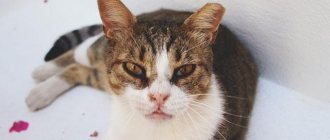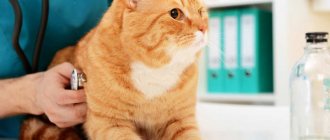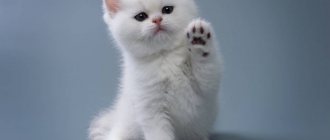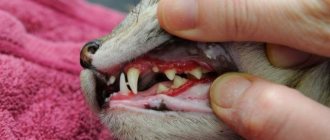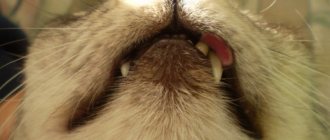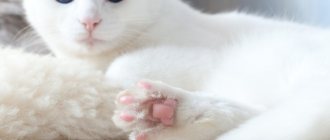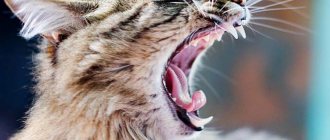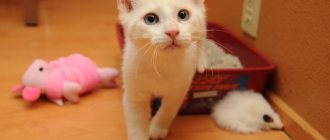Not only people, but also pets face the problem of excess weight. Obesity is the accumulation of fat in the body, which causes weight gain. At the same time, fatty layers form under the skin and around the internal organs. Does obesity in cats affect their health?
Obesity in cats - a problem or not?
Consequences of obesity in cats
Many pet owners rejoice when their pet's silhouette is rounded. They think it's cute and funny. But obesity does not have the best effect on the condition of cats. Fat deposition leads to many disorders and diseases:
- liver pathologies;
- fatty degeneration of organs, when lipids are deposited on the heart, kidneys, pancreas;
- diabetes;
Excess weight provokes the development of diabetes
- diseases of the musculoskeletal system - arthritis, arthrosis, spine pathologies;
- idiopathic cystitis;
- urolithiasis disease;
- impaired cardiovascular activity, thrombosis, weakness of the heart muscle;
- pulmonary failure;
- oxygen starvation;
- formation of cholesterol plaques in blood vessels, atherosclerosis.
Reference. Idiopathic cystitis is associated with dysfunction of the urinary tract. The disease is manifested by difficulty urinating, blood in urine, ignoring the tray, etc. In males, complete blockage of the urethra is possible.
Problems with joints force the animal to lead a sedentary lifestyle. As a result, body weight increases even more, and the circle closes.
A sick pet brings a lot of trouble and anxiety to its owners and mistresses. Read our article and find out what diseases cats have and what signs indicate health problems in a cat.
In addition, behavior changes. The cat becomes apathetic and lazy. At the same time, unmotivated aggression towards the owners or surrounding animals may also appear.
An overweight cat becomes lethargic
An obese cat tolerates surgery and anesthesia less well. Excess weight affects the ability to conceive and bear offspring, and complications during childbirth. The animal looks unkempt because it is unable to take care of its cleanliness.
Video - Obesity in cats and dogs
How likely is heartburn (reflux - esophagitis) to occur after prostate cancer? How to deal with this?
Firstly, the probability of reflux of stomach contents into the esophagus largely depends on the volume of resection, i.e. the larger part of the stomach is removed and the more the stomach looks like a narrow tube, the less the danger of reflux of gastric contents into the esophagus. Secondly, reflux esophagitis can be effectively treated and prevented with the help of antiulcer drugs (omez, quamatel, ranitidine, pariet, etc.) that inhibit gastric secretion. Such treatment can be prescribed for a period of 2 - 3 months after surgery, and then only if necessary. We are not proponents of additional “anti-reflux” interventions. They are justified only when it comes to large diaphragmatic hernias.
Causes of obesity in cats
There are several causes of obesity in a cat, and sometimes they are combined.
Sterilization is a major risk factor
Owners who are not involved in breeding resort to spaying and neutering of cats. However, this category of animals is at risk. Their excess weight gain is explained by changes in hormonal levels and metabolic mechanisms. As a result, appetite can increase by 20% and calorie expenditure by 30%.
Loss of fertility increases risk of obesity
Reference. The likelihood of obesity in animals deprived of reproductive functions is 3.5 times higher than in relatives capable of reproduction.
After sterilization, the body’s adaptation period lasts 2 months. If you don't change your diet, your cat's weight can increase by one and a half times.
Cat Breeds Prone to Weight Gain
Some cats have a genetic predisposition to obesity. These are the majority of small and medium breeds. At risk are the Persians and the British, who are known gluttons and lovers of sweets and starchy foods.
Persian cats love to eat
Unbalanced diet
This is the third factor that contributes to the formation of fat deposits. When preparing a diet, owners make the following mistakes:
- feeding an animal beyond measure;
- high-calorie foods;
- indulging the whims of the cat when he begs;
- abuse of treats.
I eat without moderation!
Other reasons
Weight gain is a consequence of physical inactivity, or a sedentary lifestyle. If a cat consumes more calories than it expends, it will inevitably gain weight.
This problem also manifests itself in metabolic disorders. The disorder is caused by malfunctions in the functioning of internal organs - the pancreas and thyroid glands, the pituitary gland, and the adrenal glands.
Escape from physical inactivity
Symptoms of weight gain in cats
There is no universal weight standard for cats. This indicator is determined for each breed separately. You should be wary if the figure exceeds the average figures for a particular species by 15–20%.
Weight standards for cats
However, symptoms can be recognized visually and by touch. Fat deposits form in the lower abdomen - a thick fold forms in this area, and on the sides. When you feel the chest part of the body of a cat with normal body weight, the ribs are felt, but in pets that are overweight, they are not.
In addition, the following signs indicate a weight problem:
- sagging abdomen;
- a lounging, unhurried gait;
- indifference to the environment, drowsiness;
- dyspnea;
- increased fatigue.
Signs of obesity in a cat
How new is this operation?
Indeed, longitudinal (synonyms: reduction, sleeve, tubular, vertical) gastrectomy is a relatively new bariatric operation. I used the word “comparatively” because in fact, longitudinal gastrectomy (LG) is an integral part of the biliopancreatic bypass operation in the Hess-Marceau modification, known in the world since the early 1990s and successfully used in our clinic since 2003. Therefore, we can confidently say that the technical details of this operation have already been well worked out. However, as an independent operation, PRG was first performed in the USA in the early 2000s by M. Gagner et al. as the first stage of biliopancreatic bypass surgery in severely obese patients. The calculation was made to carry out the second, “intestinal stage” of biliopancreatic bypass, in the future, as the preliminary weight loss and improvement of the patients’ condition occurred. It later turned out that in some patients, PRJ turned out to be a completely self-sufficient operation to achieve the desired weight loss. Since that time, and this is only a little over five years ago, PRG began to be used in many foreign clinics, and then in our country, as an independent operation. In our clinic, prostate cancer was first performed as an independent operation in 2004.
Treatment of obesity in cats
Treatment is approached in a comprehensive manner. A visit to the doctor and laboratory tests will help determine the cause of obesity. If weight gain is caused by a disease, then first they select treatment options - medications, physical therapy methods, and, if necessary, resort to surgical intervention.
A mandatory component of treatment is diet . Inexperienced owners believe that half the portion will be sufficient. However, this is a wrong approach. Malnutrition can transform into persistent meowing. And there is a chance that the family will start feeding the pet in the old way in order to silence it. Don't forget about vitamins.
Feline vitamin deficiency
Attention! Body weight loss should not exceed 1–3% per week. Otherwise, serious health problems may arise.
Weight stabilizes gradually. Sometimes this takes up to 12 months.
If the cause is a disease, appropriate treatment is selected
Diet and food for cats with obesity
Manufacturers have developed special diets for such cats. These are low-calorie dry and wet foods that promote weight loss, including medicinal ones. They also have an increased protein content to maintain muscle mass.
Table 1. Medicinal foods for weight loss.
| Name of food | Package weight, kg/price, rub. | Product Features |
| Advance Obesity Management | 1,5/1130 |
|
| Royal Canin Obesity Management DP42 | 1,5/1300; 0,4/450 |
|
| Proplan OM Obesity Management | 1,5/1200 |
|
After stabilizing the weight, they switch to food that helps maintain shape. The manufacturers listed above also have these products.
Therapeutic foods help stabilize weight
Natural nutrition
The media talk about the miraculous weight loss of the cat Fidget, whose owners put him on a protein diet, giving him only fresh meat and sausages. People are familiar with this diet as the Kremlin diet, or Atkins (naturally, sausages are not included in the diet).
Miraculous weight loss for a cat
Nutritionists are against this method of nutrition, since excess protein affects the kidneys, which are considered the weak point of cats. This results in other problems with the body - fecal poisoning. Therefore, in addition to protein, the diet should include cereals and vegetables.
The cat should be fed as if it were of normal body weight. Approximate diet for an animal 4–5 kg:
- meat (rabbit, poultry, veal, beef) - 70 g;
- cereals cooked in water (rice, buckwheat, corn grits) - 50 g;
- cottage cheese (0% fat) - 30 g;
- boiled vegetables (cabbage (white or cauliflower), carrots, zucchini) - 100 g.
As directed by the doctor, vitamin preparations are given according to the instructions. When the cat's weight returns to normal, reduce the amount of cereals in favor of cottage cheese.
Delicacies from the master's table are taboo
If the cause of weight gain is overeating, the daily portion is not reduced immediately, but gradually, decreasing by a quarter every week until it reaches the standard weight. Nutrition adjustments are made every 1-1.5 months. Be sure to stop feeding foods from your table that are not intended for cats.
Video - How many times a day to feed a cat
Delicious additives
If your animal has been prescribed a diet, then completely all treats must be excluded from its diet. Very often, owners feed their favorite creature with goodies from their table. Sweets, sour cream, chocolate and other products are used. Most of them are very harmful to cats. It is these supplements that lead to obesity. And during a diet, they are out of the question. Even treats from pet stores are prohibited. You will also have to give them up during treatment. It would seem that harmless additives can lead to undesirable consequences. Therefore, the diet must be strictly followed.
Combating a sedentary lifestyle
Correction of the diet should be accompanied by an increase in the animal’s activity.
Important! Cats, compared to dogs, are not marathon runners, but sprinters. This means they are capable of short bursts of activity rather than long walks. This fact is taken into account when creating a weight loss program.
Overweight cats are initially not ready for increased physical activity. In the first week, you can get them to move more by moving the food dishes away from the bed. If the cat is walking in the yard, then the bowls are placed around the house, distributing the entire single meal between them.
Favorite toys - for example, fishing rods - will stimulate a lazy cat. Some animals, like dogs, can bring thrown objects - small rubber toys, pencils (not sharpened ones). If, after a training session, you treat your pet with a small piece of lean meat or a vitamin-rich treat, this will stimulate interest in games.
Feeder ball
It doesn’t matter if the owner leaves the pet alone for a long time. There are many pet products that will encourage him to play independently. Thus, running wheels are on sale, as well as toys-feeders for animals. In order to get food, the pet must work hard physically.
A running wheel is a great way to keep your couch potato cat in shape. In this article on our portal, we’ll look at what types of running wheels for cats are and how to choose the right one for your pet. For handmade lovers, there is a special section on how to make a running wheel with your own hands.
Video – Interactive complexes for cats
Owner behavior
Caring for a pet during its treatment requires changes in the behavior of the owner himself. He should set an example, in particular, forget about often sitting in a chair or lying in bed. You will have to work with your pet more often, captivating him, not allowing him to constantly sleep or even just lie down. It's good when children in the family involve the cat in their games. At the same time, you should not limit her movement.
A cat has no business being in the kitchen or near the table during family meals. It is necessary to immediately take it to its place. The animal should receive food only in a separate area, remote from both the kitchen and its “bedroom”. “Begging” and accepting food from the common table should be strictly prohibited. Feeding should be done only according to the established regime and diet. No extra treats. Affection and encouragement should not be associated with food. The remaining food in the bowl is removed after feeding.
It is necessary to regularly monitor the weight of your pet. Weighing should be done daily, recording the readings. It is important to identify the general trend of changes. If a slight but stable weight loss is observed, treatment must be continued. If no effect is detected, you should contact your veterinarian again. You may have to change your approach to diet and switch to special foods.
Special care is necessary in the presence of pathological internal causes of obesity associated with chronic diseases. In this case, the doctor must accurately diagnose the pathology and prescribe medication. The owner’s task becomes the timely administration of prescribed medications.
If there are several cats in the house
It happens that there are many cats living in a house, but only one of them is obese. In this case, feeding regimes are different. Organization of the process causes some difficulties for breeders.
Veterinarians offer several options for solving the problem. For example, they practice isolated feeding. Cats are given food at the same time, but in different rooms, and are given 15–20 minutes to absorb it. At the end of the meal, check whether all the food has been eaten. What is left is removed until next time or thrown away.
If there are several cats in the house, the task becomes more complicated.
Another way is to place bowls of food for cats of normal weight on the upper floors of the home. At first, it is not easy for overweight animals to get to high-lying food, so their dining room is located on the ground floor.
Proper nutrition
When a pet appears in the house, you will be faced with the question of what type of food you will prefer. You can opt for natural products or buy industrial feed. In this case, the prepared food must be premium or super-premium.
If you prefer natural feeding, then your four-legged friend’s menu should include the following products:
- Boiled sea fish.
- Meat without bones and skin (rabbit, turkey, beef, chicken).
- Low-fat dairy products (up to 5% fat).
- Vegetables and fruits in moderation.
- By-products are allowed no more than twice a week (peeled and boiled).
Don't forget about mineral supplements and vitamins. They should be present in the diet regularly. It is difficult to correctly calculate the volume of products offered to an animal. After all, all pets are different and lead different lifestyles, so they require different portions of food. In general, by experience you can learn to determine whether your pet has enough food. If the cat does not finish the portion, the leftovers must be removed so as not to disrupt the diet and prevent overeating.
With ready-made food, it is much easier to determine food intake norms. The packaging indicates how much food the animal needs based on age and weight. If the owner gives more food than necessary, the pet will begin to gain weight.
Preventing excess weight gain
Hippocrates’ opinion that it is easier to prevent a disease than to treat it is also relevant in relation to representatives of the fauna.
It’s easy to keep a cat in this shape
To keep your cat at a normal weight, you need to follow simple recommendations from veterinarian nutritionists. And they are like this:
- You cannot give an animal more food at his request. The portion is increased only if the body requires more energy. For example, the daily dose of food is increased for pregnant and lactating females.
- You should follow a routine and give food at the same time.
- Pets should not eat any of the dishes that the owner prepares for himself. Fatty, salty, smoked foods are prohibited.
- It is necessary to take care of sufficient physical activity. Toys and a climbing slide can stimulate mobility.
- You should visit the clinic regularly in order to detect diseases and organ dysfunctions in a timely manner.

